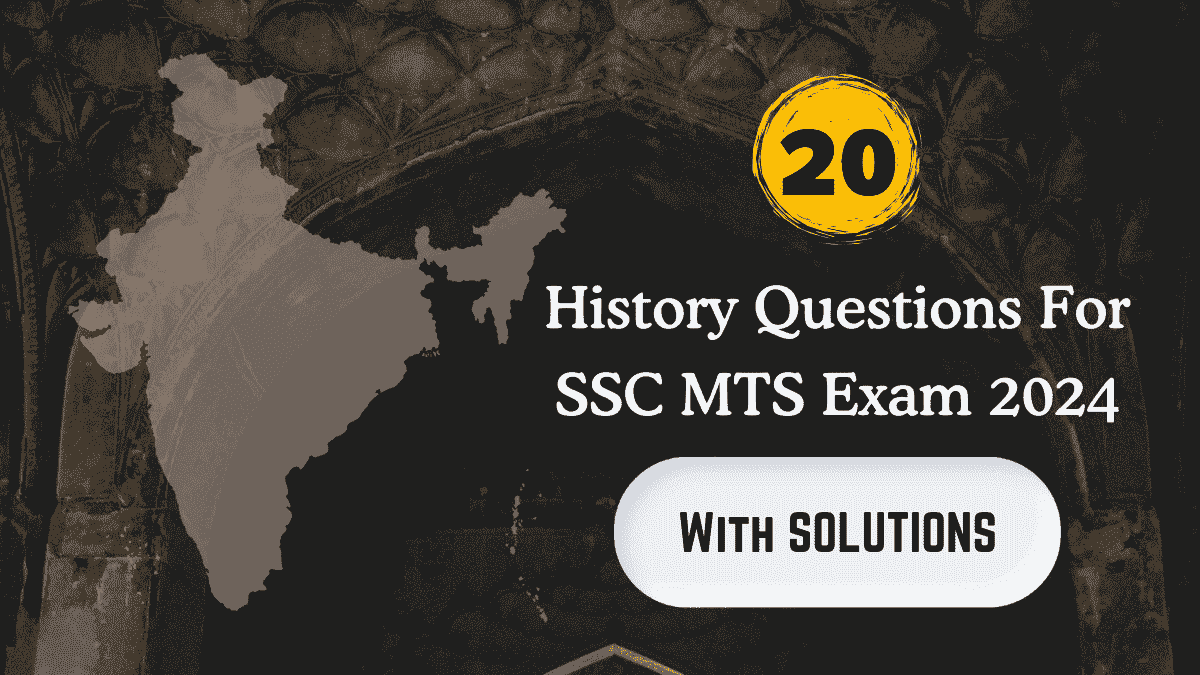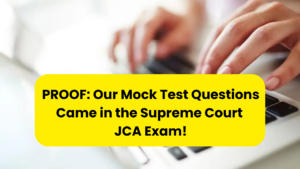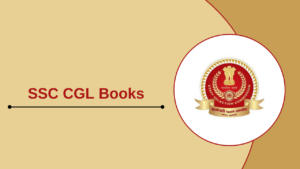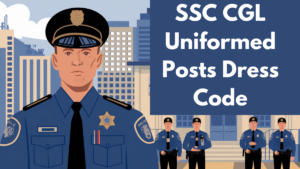Table of Contents
Candidates appearing in the upcoming SSC exams can find 20 useful history questions for the SSC MTS Exam 2024. The Staff Selection Commission conducts a highly competitive recruitment exam for 10th pass candidates to recruit them for the Multi-Tasking Staff or Havaldar post. In this Computer-Based Exam, history questions are an important part of the General Awareness section in Session II.
History Questions for SSC MTS Exam 2024
The General Awareness section includes 25 questions worth 75 marks. These questions are distributed relatively equally across various static subjects and current affairs. Around 2-4 questions from History may be asked in the SSC MTS Exam based on the previous years’ pattern. Candidates aspiring to get a government job through SSC MTS 2024 can easily prepare for the History questions by practicing maximum objective questions.
20 Important History Questions for SSC MTS 2024
In this section, we have listed 20 important questions from Ancient, Medieval, and Modern History to help you prepare for the upcoming SSC MTS Exam 2024.
Q1. In India, artillery was first used in the Battle of
- Panipat
- Talikot
- Sialkot
- Khanwa
Q2. In the Mansabdari system, the Commander-in-Chief of the Army was
- Mansabdar
- Emperor
- Prince
- Dash Hazari
Q3. Who was the first editor of the Jugantar?
- Barindra Ghosh
- Bipin Chandra Pal
- Jatindra Nath Mukherjee
- Ullaskar Dutt
Q4. From which of the following places was the Civil Disobedience Movement started by Gandhiji in 1930?
- Sevagram
- Dandi
- Sabarmati
- Wardha
Q5. Which among the following cities is considered one of the oldest surviving cities in the world?
- Mathura
- Varanasi
- Haridwar
- Ayodhya
Q6. The Battle of Talikota was fought in –
- 1526 A.D.
- 1565 A.D.
- 1576 A.D.
- 1586 A.D.
Q7. Amir Khusrau played a pioneering role in the development of –
- Braj Bhasha
- Awadhi
- Khari Boli
- Bhojpuri
Q8 Where and when was the Ghadar Party founded?
- United States of America, 1913
- England, 1917
- Denmark, 1921
- Scotland, 1925
Q9. The Silk Letter Conspiracy (1916) was organized by____
- Maulana Obeidullah Sindhi and Maulana Mahmud Hasan
- Maulana Abdul Bari and Maulana Muhammad Ali
- Maulana Abul Kalam and Maulana Mahmud Hasan
- Raja Mahendra Pratap and Jon Henting
Q10. Who among the following leaders dominated the Lucknow Pact in December 1916?
- Jawahar Lal Nehru
- Bal Gangadhar Tilak
- Moti Lal Nehru
- Madan Mohan Malviya
Q11. Which one of the following pairs is not correctly matched?
- Purna Swaraj Resolution – 1929
- Martyrdom of Sardar Bhagat Singh – 1931
- Formation of Congress Socialist Party – 1938
- Shimla Conference – 1945
Q12. Who pioneered guerrilla warfare methods?
- Babur
- Akbar
- Shivaji
- Bajirao Peshwa
Q13. Humayun’s Tomb was built by_____.
- Humayun
- Hamida Banu Begum
- Babur
- Akbar
Q14 Which is the first Hindi newspaper of India?
- Udaan
- Azad Vichaar
- Udant Martand
- Vichaar Vyakti
Q15. Who started Ganesha Festival?
- Mahatma Gandhi
- Lokmanya Tilak
- Pandit Nehru
- Indira Gandhi
Q16. When did the ‘Jallianwala Bagh’ tragedy take place?
- 13th April 1867
- 15th June 1947
- 13th April 1919
- 17th May 1911
Q17. In whose coins was the wheel found?
- Menander
- Demetrius
- Kanishka
- Nahapana
Q18. One of them was not conquered by Kanishka from China. Identify.
- Khotan
- Yarkand
- Kashgar
- Kapisa
Q19. Who among the following is referred to as the ‘Sadhu from the West’?
- Thomas of Cannan
- St Thomas
- St Bartholomew
- None of the above
Q20. The battle of Haldighati in 1576 was fought between Akbar and _______.
- Sher Shah
- Maharana Pratap
- Hemu Vikramaditya
- Nader Shah
Solutions
| SSC MTS History Questions – Answer Key | |||
| 1 (a) | 6 (b) | 11 (c) | 16 (c) |
| 2 (b) | 7 (c) | 12 (c) | 17 (a) |
| 3 (a) | 8 (a) | 13 (b) | 18 (d) |
| 4 (b) | 9 (c) | 14 (c) | 19 (b) |
| 5 (b) | 10 (b) | 15 (b) | 20 (b) |
S1. Ans. (a)
Sol. It was first used by Babur to achieve an empire of Hindustan during the First Battle of Panipat against the forces of the Sultan of Delhi, Ibrahim Lodi in 1526.
- Mughal artillery consisted of heavy cannons and light artillery.
- Battle of Talikota (1565) was fought between the Vijayanagar Empire and four allies of the Deccan Sultanates.
- Battle of Khanwa (1527) was fought between Babur and Rajput alliance led by Rana Sanga.
S2. Ans.(b)
Sol. Mansabdari System was a system introduced by Akbar for military administration and territorial commands (grant and revenue) to sustain parts of the army. In Mansabdari, the Emperor is the Commander-in-chief of the Army.
- Under this system, every official or officer was assigned a rank (called Mansab) and was required to maintain a specified number of troops. The higher the Mansab, the more troops the officer had to maintain. The emperor held the highest rank of Mansabdar.
S3. Ans.(a)
Sol. Jugantar Patrika was a Bengali revolutionary newspaper founded in 1906 in Calcutta by Barindra Kumar Ghosh, Abhinash Bhattacharya, and Bhupendranath Dutt.
- A political weekly, it was founded in March 1906 and served as the propaganda organ for the nascent revolutionary organization Anushilan Samiti which was taking shape in Bengal at the time.
S4. Ans. (b)
Sol. It was started with Dandi March (also Salt March, Salt Satyagraha) by Mahatma Gandhi on 12th March 1930.
- On 12 March 1930, he along with his 78 followers began a march from the Sabarmati Ashram to “Dandi” on the Gujarat coast.
- It was a distance of 200 miles.
- At Dandi a few days later they violated the salt laws by making salt from seawater. Thus began the civil disobedience Movement.
S5. Ans. (b)
Sol. Varanasi or Kashi is situated on the bank of the holiest river of India “The Ganges”.
- Varanasi “The city of temples” is one of the oldest cities in the world.
- Varanasi is also known as the “Religious capital of India”.
- The city has been India’s culture and religious centre for several years.
- Some believe that it has been established by Shiva.
S6. Ans. (b)
Sol. The battle of Talikota (26 January 1565) also known as the Battle of Rakshasa-Tangadi, a watershed battle was fought between the Vijayanagara army led by Rama Raya and his two younger brothers and the Deccan sultanates including Bijapur, Ahmadnagar, Golkonda, and Bidar, resulted in a defeat of Vijayanagara ended in weakening one of the greatest Indian empires originating from southern India before the Maratha Empire.
- Talikota is situated in north Karnataka near Bijapur city.
S7. Ans. (c)
Sol. Amir Khusrau learned various Indian dialects especially Hindi which he loved most. He played a pioneering role in the development of Khari Boli.
- Merchants in the Mughal Empire used it because they needed a common commercial language.
- Hindustani is based on an early dialect of Hindi, known by linguists as Khari Boli, which originated in Delhi.
S8. Ans. (a)
Sol. In 1913, the Pacific Coast Hindustan Association, later called the Ghadar Party, was founded by Lala Hardayal with Sohan Singh Bhakna as its president.
- Founded in the city of San Francisco, California, USA.
- They published a weekly newspaper called “Ghadar” in which they spread their revolutionary message and called for an armed uprising against British rule in India.
S9. Ans. (c)
Sol. The Silk Letter Movement refers to a movement organized by Deobandi leaders between 1913 and 1920.
- Aimed at gaining Indian independence from British rule by forming an alliance with the Ottoman Empire, the Emirate of Afghanistan, and the German Empire.
- This plot was uncovered by the Punjab CID with the capture of letters from Ubaidullah Sindhi, one of the Deobandi leaders then in Afghanistan, to Mahmud Hasan Deobandi, another leader then in Hejaz.
- The letters were written on silk cloth, hence the name.
S10. Ans. (b)
Sol. Lucknow Pact refers to an agreement reached between the moderates, militants, and the Muslim League at the joint session in Lucknow, in the year 1916.
- It also established cordial relations between the two prominent groups of the Indian National Congress the extremists and the moderates.
- The Extremists were led by Bal Gangadhar Tilak, while the Moderates were led by Gopal Krishna Gokhale.
S11. Ans.(c)
Sol. Congress Socialist Party, or (CSP), was a left-wing group within the Congress. It was formed with Acharya Narendra Deva as President and Jay Prakash Narayan as General Secretary in 1934.
- It was later dissolved in 1938.
- The Purna Swaraj Resolution was adopted by the Indian National Congress on January 26, 1929, declaring India’s independence from British colonial rule.
- Bhagat Singh was executed by the British colonial authorities on March 23, 1931.
- The Shimla Conference actually took place in 1945-46, where Indian leaders, including Mahatma Gandhi, Jawaharlal Nehru, and Muhammad Ali Jinnah, met with British officials to discuss the future of India’s independence.
S12. Ans.(c)
Sol. Shivaji pioneered guerrilla warfare methods.
- He utilized hit-and-run tactics, surprise attacks, and ambushes to disrupt the larger and more powerful armies of the Mughal Empire and the Bijapur Sultanate.
- He also recruited local peasants and tribespeople to his cause, turning their knowledge of the land and their ability to move quickly and quietly into a strategic advantage.
S13. Ans.(b)
Sol. Humayun’s Tomb. Located in Nizamuddin East in Delhi. It is the tomb of the great Mughal emperor Humayun. It was built by his beloved wife Hamida Banu Begum.
- The construction of the tomb began in 1565 and was completed in 1572.
- The tomb is an excellent example of Mughal architecture.
- The design of the tomb is attributed to Mirak Mirza Ghiyas, a Persian architect who was appointed by Hamida Banu Begum.
S14. Ans.(c)
Sol. Udant Martand (The Rising Sun) was the first Hindi-language newspaper published in India. Starting on May 30, 1826, from Calcutta (now Kolkata), Pt. Jugal Kishore Shukla published the weekly newspaper every Tuesday.
- The newspaper was printed in the Nagari script and aimed to promote education and social reform in the Hindi-speaking regions of India.
- Udant Martand played an important role in the growth and development of Hindi journalism, paving the way for many other Hindi newspapers to follow in the coming years
S15. Ans.(b)
Sol. Lokmanya Tilak started Ganesh Festival in 1893 to bring people together and to create a feeling of patriotism.
- Tilak chose to celebrate the Ganesha festival because it was a popular and widely celebrated festival in Maharashtra, where he was based.
- He saw the festival as an opportunity to mobilize people and build a sense of community among the masses.
S16. Ans.(c)
Sol. The Jallianwala Bagh massacre, also known as the Amritsar massacre, took place on 13 April, 1919.
- A large, peaceful crowd had gathered at the Jallianwala Bagh in Amritsar, Punjab, British India, to protest the Rowlatt Act and the arrest of pro-independence activists Saifuddin Kitchlew and Satyapal.
- In response to the public gathering, the temporary brigadier general R. E. H. Dyer fired over the gathering.
- The firing continued for about ten minutes, resulting in the deaths of hundreds of people and leaving many more injured.
S17. Ans. (a)
Sol. Menander has left behind an immense corpus of silver and bronze coins, more so than any other Indo-Greek king.
- During his reign, the fusion between Indian and Greek coin standards reached its apogee.
- Menander is also known as Milinda in Indian sources.
- The wheel symbolizes the Buddhist dharma or law, and Menander I was an important patron of Buddhism in the region.
- His coins featured not only the wheel but also other Buddhist symbols such as the elephant, the lotus, and the Triratna (the “three jewels” of Buddhism).
S18. Ans. (d)
Sol. Kapisa is one of the 34 provinces of Afghanistan. Located in the north-east of the country. Its capital is Mahmud-i-Raqi.
- Kanishka’s empire extended from the Oxus River in the north to the Ganges River in the south and from the Pamir Mountains in the west to the Tarim Basin in the east
S19. Ans. (b)
Sol. The ‘Sadhu from the West’ refers to Saint Thomas, also known as Thomas the Apostle or Doubting Thomas.
- Saint Thomas was one of the twelve apostles of Jesus Christ and is believed to have traveled to India in 52AD to spread the teachings of Christianity.
- He is often referred to as the ‘Apostle of India’ and is believed to have established several Christian communities in India, particularly in the southern state of Kerala.
S20. Ans.(b)
Sol. The Battle of Haldighati was a battle fought on 18 June 1576 between the Rana of Mewar Maharana Pratap, and the Mughal emperor Akbar’s forces, led by Man Singh I of Amber.
- Although the Rajputs were ultimately defeated in the battle, Maharana Pratap continued to resist Mughal rule and became a symbol of resistance against the Mughal Empire.




 PROOF: Our Mock Test Questions Came in t...
PROOF: Our Mock Test Questions Came in t...
 SSC CGL Books, Subject-Wise Complete Boo...
SSC CGL Books, Subject-Wise Complete Boo...
 SSC CGL Uniformed Posts Dress Code
SSC CGL Uniformed Posts Dress Code



 Adda247 Job portal has complete information about all Sarkari Jobs and Naukri Alerts, its latest recruitment notifications, from all state and national level jobs and their updates.
Adda247 Job portal has complete information about all Sarkari Jobs and Naukri Alerts, its latest recruitment notifications, from all state and national level jobs and their updates.